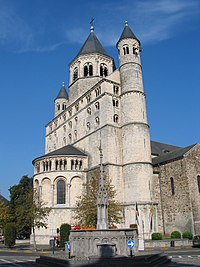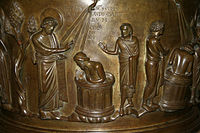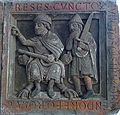Maasland art
The Maasland art (French art mosan , Italian arte mosana ) is a regional art and architecture style in the Meuse river basin in Belgium , the Netherlands and Germany , the core area is the old diocese of Liège . Although the art of the Maasland has left behind important works of art from many periods, it only refers to Romanesque art. The style reached its climax in the Maasland church building as well as the stone sculpture , the goldsmith's art , the enamel art and the illumination of the 11th to 13th centuries.
Development and dissemination of Maasland art
The Maas river basin lies in the heart of the Carolingian Empire . Maasland art therefore goes back to the Carolingian Renaissance with many elements inspired by antiquity and thus differs from the Romanesque style of other countries such as Germany, France, England and Italy.
Although the iconography of Maasland art of the 11th and 12th centuries, as everywhere, was mainly inspired by the Bible , the carved capitals in Maastricht's main churches show many scenes from everyday life as well as visions of an alien fantasy world.
The art of the Maasland mainly relates to the former diocese of Liège in what is now the Belgian provinces of Liège and Limburg , in the southern part of the Dutch province of Limburg and in the German region of Aachen . The most important artistic centers of the Diocese of Liège were the cities of Liège , Huy , Dinant , Namur , Tongeren , Maastricht and Aachen , as well as the abbeys ( Sint-Truiden , Herkenrode , Averbode , Munsterbilzen , Susteren , Sint Odiliënberg , Rolduc , Burtscheid , Kornelimünster , Stavelot , Floreffe , Nivelles , Aulne , Flône , Celles , Gembloux and Lobbes ).
Maasland art had a great influence on neighboring regions, such as the archbishoprics of Utrecht and Cologne , and the Landgraviate of Thuringia .
Major works of Maasland art
The Romanesque art of the Maasland has been described as the first golden age of the Netherlands (before the South Dutch and North Dutch golden ages ). Mostly medieval Dutch literature is also counted among the highlights of Maasland art, although one writer is known by name, Heinrich von Veldeke .
architecture
The architecture in the Liège prince-bishopric represents a special direction of the Romanesque . The architecture of the 12th century is a compromise between older Maasland traditions and foreign influences, mainly from the Rhineland and Italy . Closed west works , dwarf galleries and choir towers characterize the more mature Maasland architecture.
- Former Saint-Barthélemy collegiate church , Liège
- Saint-Denis (Liège) Former collegiate church of Saint-Denis , Liège
- Former Saint-Jean collegiate church , Liège
- Former Notre-Dame Collegiate Church , Huy
- Former collegiate church of Saint-George et Saint-Ode , Amay
- Former collegiate church of Saint-Étienne , Waha
- Former collegiate church, Fosses-la-Ville
- Former Saint-Gertrud collegiate church , Nivelles
- Former Collegiate Church of St. Servatius , Maastricht
- Church of Our Lady , Maastricht
- Former abbey church, Aldeneik
- Former abbey church, Rolduc
- Former Abbey Church of St. Amalberga , Susteren
- Former abbey church, Sint Odiliënberg
- Former abbey church, Lobbes
- Former Saint-Hadelin Abbey , Celles
- Former abbey church of Saint-Pierre et Saint-Remacle, Stavelot
Maastricht , St. Servatius , westwork
Maastricht, Church of Our Lady , east choir
Susteren Abbey Church , westwork
St. Hadelin, Celles
Rolduc Abbey , interior
Romanesque architectural sculpture
Maasland architectural sculpture reached a high point in Maastricht , Liège and Nivelles in the 12th century . Maastricht 'Metsen' ( stone cutters ) worked on capitals and reliefs in Utrecht , Bonn and Eisenach .
- Capitals in the crypt of the abbey church, Rolduc Abbey (around 1138–1143)
- Capitals in the galleries of the westwork St. Servatius , Maastricht (around 1140–1150)
- Capitals in the east choir of the Church of Our Lady , Maastricht (after 1150)
- Capitals in the Landgrave House in the Wartburg near Eisenach (around 1160)
- Vierge de Dom Rupert , relief (around 1150), Curtius Museum, Liège
- Pierre Boudon , relief (12th century), Curtius Museum, Liège
- Samson Portal, St. Gertrude Collegiate Church , Nivelles
- Baptismal font, Furnaux ( Namur )
- Oath on the relics , relief (around 1160), Church of Our Lady, Maastricht
- Majestas Domini Tympanum (12th century), St. Servatius, Maastricht
- Double relief (around 1160), St. Servatius, Maastricht
- Relief made of 4 parts (around 1150), St. Peter, Utrecht
Maastricht , Church of Our Lady , quadruple capital
Maastricht, St. Servatius , capital in the westwork
Utrecht , St. Peter, relief from 4 parts
Goldsmithing
Maasland art reached a climax in the works of goldsmithing by Reiner von Huy , Godefroy von Huy and Nikolaus von Verdun . The gold-plated reliquary shrines of Nikolaus von Verdun in Cologne , Siegburg and Tournai are major works of medieval art. The art of enamel also reached a high level during this period.
- Baptismal font (around 1107–1118) by Reiner von Huy, Saint-Barthélemy in Liège
- Portable altar by Stavelot (around 1140–1150), Musées royaux d'art et d'histoire , Brussels
- Alexander reliquary with the head of Pope Alexander I (around 1140–1150), Musées royaux d'art et d'histoire, Brussels
- Remaklus retable (around 1150), formerly in the Stavelot monastery
- Stavelot Triptych (around 1156/58), Morgan Library & Museum , New York
- Servatius Shrine (around 1165), St. Servatius , Maastricht
- Barbarossa chandelier (1165–1170), Aachen Cathedral
- Hadelinus Shrine (around 1170), Collegiate Church of St. Martin and St. Hadelin, Visé
- Domitianus Shrine, (around 1176), Huy
- Foot of the cross from Saint-Bertin Abbey (around 1180), Saint-Omer Museum
- Pentecost table (c. 1160/70), Musée national du Moyen Âge , Paris
- Shrine of the Three Kings (1180) by Nikolaus von Verdun, Cologne Cathedral
- Anno Shrine (1183) by Nikolaus von Verdun, Michaelsberg Abbey , Siegburg
- Shrine of Mary (1205) by Nicholas of Verdun, Cathedral, Tournai
- Karlsschrein (1215), Aachen Cathedral
- Shrine of Mary (1220–1239), Aachen Cathedral
- Maurus Shrine (1225–1230), Bečov Castle in Bečov nad Teplou
- Remaklus Shrine (1268), Stavelot
Baptismal font by Reiner von Huy , Liège
St. Remaclus Shrine, Stavelot
Servatius Shrine, Maastricht
Barbarossa chandelier , Aachen Cathedral
Wall painting, book illumination
Very little remains of the once famous Maasland wall painting. In his Parzival, Wolfram von Eschenbach praises the Maastricht (and Cologne) painters. The Illumination in the former Bishopric of Liege was highly developed in the second half of the 12th century. The most important centers were the Abbey of St. Laurent in Liège and the Abbeys of Stavelot and Lobbes .
- Ceiling painting (heavily restored), St. Servatius , Maastricht
- Bible from Stavelot (1093–1097), British Library , London Add MS 28106 and 28107
- Floreffe's Bible (around 1170), British Library, London Add MS 17738
- Evangeliar of Averbode (to 1165-80), University Library, Liege Ms. 363
- Manuscripts from the Sint-Truiden Abbey
- Gospels of Notker , Liège, Musée Curtius (10th - 12th centuries)
Ceiling painting, St. Servatius , Maastricht
Bible from Stavelot, British Library , London
Gospels of the Notker of Liège , Liège, Musée Curtius. Ivory and enamel
Individual evidence
- ↑ JJM Timmers: De Kunst van het Maasland . Volume 1: Romaanse period . Assen 1971.
- ↑ Pictures of the Stavelot Altarpiece .
- ↑ page at the museum .
- ↑ Parzival 158, 13–16 ( page no longer available , search in web archives ) Info: The link was automatically marked as defective. Please check the link according to the instructions and then remove this notice. .
literature
- Jan Joseph Marie Timmers: De art van het Maasland . Volume 1: Romaanse period . Van Gorcum, Assen 1971
- Anton Legner (Ed.): Rhine and Maas. Art and culture 800–1400. An exhibition by the Schnütgen Museum of the City of Cologne and the Belgian ministries for French and Dutch culture. Schnütgen Museum, Cologne 1972
- Gretel Chapman: Mosan art . In: Dictionary of the Middle Ages . Vol. 8, Scribner, New York 1987, pp. 495-496.
- E. den Hartog: Romanesque Architecture and Sculpture in the Meuse Valley (= Maaslandse Monografieën . Groot formaat Vol. 8). Eisma, Leeuwarden-Mechelen 1992.
- Adrianus Maria Koldeweij: Mosana, arte . In: Enciclopedia dell'arte medievale . Vol. 8. Treccani, Rome 1997 ( online )
- Elizabeth den Hartog: Romanesque Sculpture in Maastricht . Maastricht 2002, ISBN 90-72251-31-8
- Benoît Van den Bossche (Ed.): L'Art mosan. Liège et son pays à l'époque romane du XIe au XIIIe . Éditions du Perron, Liège 2007, ISBN 978-2-87114-217-1
- Sophie Balace: Historiographie de l'art mosan . Dissertation University of Liège 2009 ( online )





























